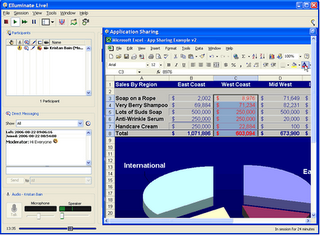Introduction
Synchronous media brings together three historic trends that have broadened the reach of education in the United States. The first, in point of qualitative impact, was the arrival of educational television in the classroom in the 1960s. Second was the impetus and desire for distance learning, serviced by ordinary mail for more than 120 years now (Holden and Westfall, 2006). Third and most recent is, of course, the gradual widening of Internet access by households starting in the mid-1990s. When broadband access to the Worldwide Web became a reality for educational institutions, the result was a tremendous increase in online learning throughout higher education and down to the K-12 levels.
Since around 2002, another explosion in “Web 2.0” technologies commenced and this resulted in an embarrassment of riches in instructional media choice. While it is beyond the scope of this very short review to extensively profile the media available, suffice it to say that these embrace stand-alone information channels and systems that combine one or more media (hence, the term “multi-media” so beloved of education technologists). In any case, the single components include Internet relay chat, email, file sharing, voice-over-Internet Protocol telephony (VoIP, the best-known stand-alone example being Skype), Internet Messaging (IM), sharing facilities (calendars, pictures and assignment files), and mobile phones that have gained access to the Web (Kawachi, 2007). There is also the combination of audio and static or streaming video popularly known as “webinar” (for Web-based seminar).
The wide spectrum of choices simply reinforces the central role of media selection in the Instructional Systems Design process. The first and foremost criterion, Holden and Westfall (op. cit.) suggest, is that the channel or medium chosen for distributed/distance instruction should enable the desired learning. It is in this light that we evaluate one of the available choices, the Elluminate Learning Suite package.
Details of the Elluminate Program
The Elluminate LS packages four of the company offerings so that schools may offer both teachers and students a comprehensive solution (Elluminate Inc., 2009). These components are:
- For the course content planning stage – The Elluminate Plan!™ component enables the organization, scripting, and assembly of lesson content and activities. Even at this stage, teachers can already automate many routine tasks that take place during the live session.
- During online classes – The Elluminate Live!® part enables synchronous (real-time) interaction and collaboration between instructors and students. An example is the Webinar setup shown overleaf.
- Post-class Synthesis and Asynchronous Learning – The Elluminate Publish!™ program is for producing standalone recordings, audio podcasts, or HD video broadcasts from Live! class recordings. Audio and video files can be archived and accessed from desktop PC’s, a learning management system archive, the school Web site, or CD-ROM. Given the technology available to students these days, this flexible archiving feature means lessons can be reviewed offline infinite times on laptops, home computers and iPods.
Beyond the selling points articulated by the company, hands-on use of Learning Suite establishes that the virtual classroom setting permits much vital interaction and collaboration to take place. The specific features that one greatly appreciates are: many-to-one interaction; an instructor can incorporate polls, questionnaires-based surveys, and quizzes to enhance interaction; participants can write comments or sketch diagrams in the whiteboard area; participants can chat and send messages to each other; display of pre-recorded audio and video; instructor-paced display of graphics and slides; when there are visiting lecturers, a log with their contact information can be easily prepared and displayed at the end of the session; and, just like in the physical classroom, the instructor can maintain orderly interaction with such features as the mute button and “raise hands” function (Nash, 2008).
Figure 1: Elluminate Webinar Screen Shot

References
- Elluminate Inc. (2009). Products. Web.
- Holden, J. T. Ed.D. & Westfall, P. J.-L. Ph.D. (2006).An instructional media selection guide for distance learning. Chairmen Emeriti, United States Distance Learning Association. Boston, MA: USDLA.
- Kawachi, P. (2007) Synchronous media in education: Summary. Web.
- Nash, S. S. (2008). How to use Elluminate’s new program to fast-track branded online course creation. E-Learning Queen. Web.